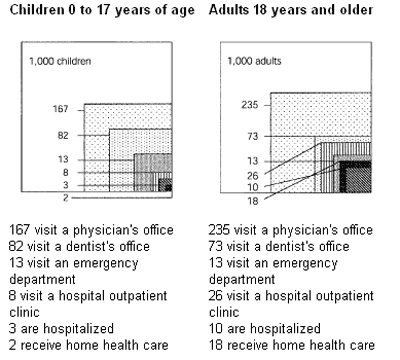
Am Fam Physician. 2003;68(12):2310
If equal and adequate access to health care for children in the United States is a goal, we are failing. That failing is most prominent in the setting where most children receive care and preventive services—the doctor's office.
Data from the Department of Health and Human Services reveal the number of children (younger than 18 years) in the United States who received care in a typical month and where that care was received.1 Similar estimates have been made for adults and the total U.S. population, but never for children alone. The number of children per 1,000 who received care in each of six settings can be displayed as a series of boxes (see accompanying figure)1 to contrast with adults. Compared with adults in 1996, a smaller proportion of children received health care in all but two settings, the emergency department and the dentist's office. This is not surprising, given the generally good health of children.
There were disturbing differences, however, in the likelihood of children being seen in some settings, specifically physicians' offices. A significantly smaller proportion of children were seen in physicians' offices if they were the same in all regards except: they were black (odds ratio [OR] = 0.57 [0.51, 0.64]—43 percent less), Hispanic (OR = 0.81 [0.71, 0.92]—19 percent less), uninsured (OR = 0.61 [0.52, 0.70]—39 percent less), or living in families where the head of household had not graduated from high school (OR = 0.73 [0.63, 0.83]—27 percent less), and if they did not have a usual source of care (OR = 0.40 [0.33, 0.48]—60 percent less). Interestingly, living in a rural area was not independently associated with differences in receiving care in any of the studied settings.

Providing health insurance and access to a usual source of care for all children are feasible strategies that could be achieved in the United States to help ensure that all children receive appropriate health care. The United States, the wealthiest country in the world spending the most on health care, can afford both for its children.